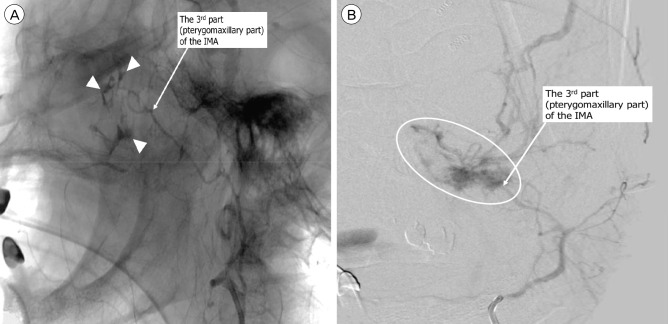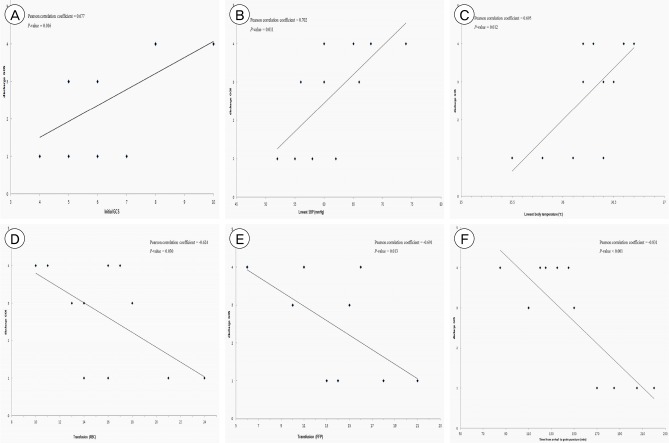J Cerebrovasc Endovasc Neurosurg.
2016 Jun;18(2):83-89. 10.7461/jcen.2016.18.2.83.
Endovascular Treatment to Stop Life-threatening Bleeding from Branches of the External Carotid Artery in Patients with Traumatic Maxillofacial Fracture
- Affiliations
-
- 1Department of Neurosurgery, Gangnam Severance Hospital, Yonsei University College of Medicine, Seoul, Korea. ns.joonho.chung@gmail.com
- 2Department of Neurosurgery, Inha University School of Medicine, Incheon, Korea.
- 3Severance Institute for Vascular and Metabolic Research, Yonsei University College of Medicine, Seoul, Korea.
- 4Department of Neurological Surgery, Rush University Medical Center, Chicago, IL, USA.
- KMID: 2354881
- DOI: http://doi.org/10.7461/jcen.2016.18.2.83
Abstract
OBJECTIVE
The purpose of this study was to report our preliminary experience with endovascular treatment (EVT) for life-threatening bleeding from branches of the external carotid artery (ECA) in patients with traumatic maxillofacial fractures.
MATERIALS AND METHODS
A total of 12 patients seen between March 2010 and December 2014 were included in this study. All subjects met the following criteria: 1) presence of maxillofacial fracture; 2) continuous blood loss from oronasal bleeding; and 3) EVT to stop bleeding. Various clinical factors were recorded for each patient and the correlations between those factors and clinical outcome (Glasgow Outcome Scale, GOS) were evaluated.
RESULTS
Four patients were injured in traffic accidents, five in falls, and three by assaults. Mean initial Glasgow Coma Scale (GCS) was 6.9 ± 2.1 and the lowest hemoglobin measured was mean 6.3 ± 0.9 g/dL. GOS at discharge was 4 in five patients, 3 in three patients, and 1 (death) in four patients. GOS on follow-up (mean 13.7 months) was 5 in two patients, 4 in three patients, and 3 in three patients. Initial GCS (p = 0.016), lowest systolic blood pressure (p = 0.011), and lowest body temperature (p = 0.012) showed a significant positive correlation with good clinical outcomes. The number of units of red blood cells transfused (p = 0.030), the number of units of fresh frozen plasma transfused (p = 0.013), and the time from arrival to groin puncture (p < 0.001) showed significant negative correlation with good clinical outcomes.
CONCLUSION
It might be suggested that rapid transition to EVT could be preferable to struggling with other rescue strategies to stop life-threatening bleeding from branches of the ECA in patients with traumatic maxillofacial fractures.
MeSH Terms
Figure
Reference
-
1. Ardekian L, Rosen D, Klein Y, Peled M, Michaelson M, Laufer D. Life-threatening complications and irreversible damage following maxillofacial trauma. Injury. 1998; 5. 29(4):253–256. PMID: 9743742.
Article2. Bynoe RP, Kerwin AJ, Parker HH 3rd, Nottingham JM, Bell RM, Yost MJ, et al. Maxillofacial injuries and life-threatening hemorrhage: treatment with transcatheter arterial embolization. J Trauma. 2003; 7. 55(1):74–79. PMID: 12855884.3. Chen CC, Jeng SF, Tsai HH, Liliang PC, Hsieh CH. Life-threatening bleeding of bilateral maxillary arteries in maxillofacial trauma: report of two cases.? J Trauma. 2007; 10. 63(4):933–937. PMID: 17110893.
Article4. Harris T, Rice S, Watts B, Davies G. The emergency control of traumatic maxillofacial haemorrhage. Eur J Emerg Med. 2010; 8. 17(4):230–233. PMID: 20603900.
Article5. Kim DY, Hyun DK, Park H, Chung J. Endovascular treatment of life-threatening bleeding of bilateral maxillary arteries in a patient with multiple facial bone fractures - a case report. J Korean Neurotraumatol Soc. 2011; 11. 7:108–111.6. Komiyama M, Nishikawa M, Kan M, Shigemoto T, Kaji A. Endovascular treatment of intractable oronasal bleeding associated with severe craniofacial injury. J Trauma. 1998; 2. 44(2):330–334. PMID: 9498506.
Article7. Sakamoto T, Yagi K, Hiraide A, Takasu A, Kinoshita Y, Iwai A, et al. Transcatheter embolization in the treatment of massive bleeding due to maxillofacial injury. J Trauma. 1988; 6. 28(6):840–843. PMID: 3385830.
Article8. Schaitkin B, Strauss M, Houck JR. Epistaxis: medical versus surgical therapy: a comparison of efficacy, complications, and economic considerations. Laryngoscope. 1987; 12. 97(12):1392–1396. PMID: 3683049.
- Full Text Links
- Actions
-
Cited
- CITED
-
- Close
- Share
- Similar articles
-
- Massive Postoperative Bleeding: A Case Report
- Endovascular Treatment of Life-Threatening Bleeding of Bilateral Maxillary Arteries in a Patient with Multiple Facial Bone Fractures: A Case Report
- Transcatheter arterial embolization for traumatic bleeding control
- Traumatic Pseudoaneurysm of the External and Internal Carotid Artery Presenting as Epistaxis: Case Report
- Four Cases of Traumatic Aneurysm in the Brances of External Carotid Artery: Report of 4 Cases



